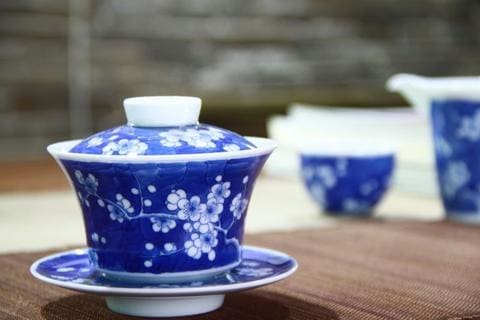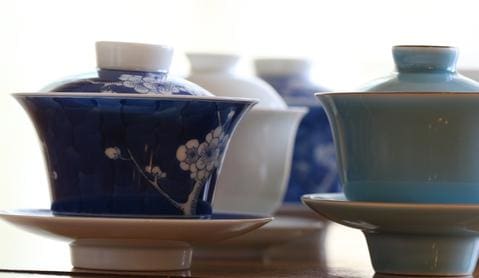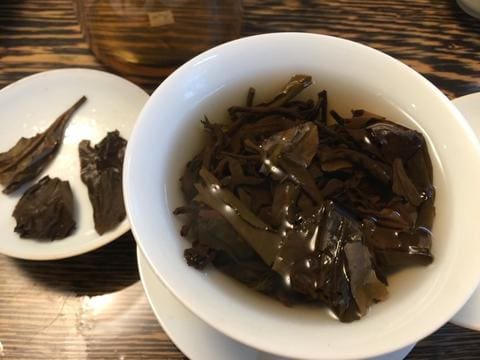
Essential Teaware Explained: Your Guide to Gaiwan and How to Use It, Part 3

Our last two blog posts have been focusing on the inimitable gaiwan, a teaware piece that represents near perfect coordination between function and form, use and aesthetic. We first explored a little of its history before considering what sorts of features makes for a good gaiwan. Today, we are going to wrap up our series by walking you through how to use one.
Traditionally, the gaiwan has been a centerpiece in gong fu tea ceremony, but numerous tea drinkers around the world have appropriated it for more casual tea-making as well. Whether you want to use it in a more formal setting or else prefer to prepare your tea more casually, there is no reason why the gaiwan cannot be for you.
But first, a word of warning. We always recommend that you practice manipulating your gaiwan without any tea or water until you develop more comfort using one. It will take some practice, but within no time, it will become second nature to you.
You may also want to practice over some soft surfaces, such as carpet, and hold your gaiwan from a safe height. This will help prevent your gaiwan from breaking should you accidentally drop it—though you still must be careful, for an accidental collision between the saucer and lid or bowl can spell bad news. For this reason, it is wise to invest in an inexpensive gaiwan before handling one that is more unique.
The Grip
Assuming that you followed our purchasing guide from last week, your gaiwan should either include a saucer or else have a pronounced foot on the bottom of the bowl. In addition, you should notice that your lid has a knob on top, enabling you to quite easily lift it from the bowl and replace it. This knob, however, is also an integral part of handling your gaiwan.
Broadly speaking, there are two main grips that people prefer when they are ready to pour from their gaiwan. The first method is to place your hand palm up underneath your gaiwan. If you have a saucer, it should be resting on top of your fingers; and if you don’t, then the foot of the gaiwan should be resting comfortably above your fingers.
(Side Note: It is at this point that those who own a gaiwan without a saucer might begin appreciating the craftsmanship in designing a foot. A narrow foot appears far more elegant, but as it gets narrower, it becomes less stable. An artist is thus challenged to find the sweet spot between maximum stability and maximum aesthetic when designing a foot. If it does not rest comfortably on your hand, then it is too narrow for its shape.)

With the gaiwan resting on your fingers, you should be able to free your thumb and move it to the top of your gaiwan, placing it right on the knob of the lid. This grip should provide enough security between all three pieces such that you can turn the gaiwan upside-down and rightside-up with ease. If it helps, imagine getting ready to lift a table; your fingers should be under the table while your thumb clamps the top of it. This is one way to hold a gaiwan.
The second method might seem a little more comfortable for western practitioners, but it also requires that your gaiwan have enough of a flared lip to prevent the dreaded finger scorching. To use this method, you will want to grip your gaiwan by the top, wrapping your fingers around the lip. In this way, lifting your gaiwan is more like lifting a cup by the rim (assuming the cup had a lid as well).
With this second method, people tend to either use their index finger or middle finger to secure and manipulate the lid. Another option is to use your free hand. In addition, you can either ignore your saucer, lifting the bowl with the lid by the lip, or else use your free hand to hold the saucer below the bowl.
The Pour
Regardless of which method you decide to use, your goal is to pour the tea from the gaiwan, and so the next step is to practice this as soon as you feel comfortable manipulating your gaiwan and all of its pieces.
Again, before attempting to do this with tea, first practice with lukewarm or cold water. Fill your gaiwan, lift it slowly using your preferred method, secure the lid with either your thumb or free hand, and get ready to pour.
The trick to a good pour is to slide the lid ever so gently to the side so that it creates a small opening, sort of like a sip cup. This small opening makes it easy for the water to flow, and it doubles as a natural strainer when you’re finally ready to add your tea leaves.
The Infusion

Now that you’ve developed some comfort lifting your gaiwan and pouring with it, you’re finally ready to prepare some tea!
Tea preparation with a gaiwan is going to require some different parameters than you’d find with a teapot or infuser. Perhaps the most notable change is the infusion time, which tends to vary between 5 and 15 seconds (as opposed to 1 to 3 minutes). This short infusion time allows you to enjoy your tea much longer, brings out more flavors, and helps prevent you from burning your fingers.
Depending on how much tea you plan to drink throughout the day, you will want to fill your gaiwan with anywhere between 4 and 8 grams of tea. This may seem like a lot, especially if your gaiwan is 100 to 150 ml, but trust us, this is very normal.
Next, pour your water over your tea leaves and then gently place your lid on top. You do not want to fill your bowl to the brim, but leave a little bit of room so that the lip of your bowl does not get too hot too quickly. By the time you lift your gaiwan and bring it to your tea cup or mug, you’re probably ready to pour it off anyway, and so this is the moment you’ve been waiting for! Create that small opening with the lid, pushing back any extra tea leaves with it, and gracefully pour your freshly brewed tea!
If you’ve made it this far, congratulations! You are opening a new world of tea drinking up to yourself!
Important Caveats
Gaiwans are not without their limitations, and so there are two important things to keep in mind if you would like to try using one.
One, unless the gaiwan is made of stoneware, it is generally not the best choice for teas that require infusion at higher temperatures, such as black teas and pu erh teas. Such a high temperature will heat your porcelain very quickly, making it easy to burn your fingers in the process.
Two, gaiwans are also not ideal for very fine tea leaves, as they tend to escape even the smallest opening between your lid and bowl as you begin pouring. Some people will address this by placing a tea strainer over their tea cup or mug, which can catch the leaves, but without one, you are better off preparing a tea like dragonwell green tea or silver needles white tea.
Keeping these caveats in mind, with plenty of practice, you’ll find your gaiwan to a welcome addition to your tea lifestyle. Working with a gaiwan might seem difficult and feel awkward at first, but like anything, it will feel more familiar and comfortable over time, and the reward is worth it!
